Influence of Vertical Load, Inflation Pressure, and Driving Speed on the Emission of Tire–Road Particulate Matter and Its Size Distribution
Abstract
1. Introduction
2. Materials and Methods
2.1. Internal Drum Test Bench
2.2. Sampling and Measuring
2.3. Varied Parameters
2.4. Experimental Setup, Test Procedure, Data Processing and Evaluation
3. Results
3.1. Influence of Vertical Load on PM Emission
3.2. Influence of Inflation Pressure on PM Emission
3.3. Influence of Driving Speed on PM Emission
4. Discussion
5. Conclusions
- Vertical load: An increase in vertical load at consistent longitudinal dynamics (constant adhesion utilization) results in a linear increase in the emission factor. This statement applies to both driving and braking. Only the vertical load has been changed, not the tire. As the vertical load increases, the mean diameter of emitted particles increases. While more coarse particles are emitted, the number of fine particles remains almost unchanged. This results in a flatter (normalized) particle number distribution.
- Inflation pressure: An increase in inflation pressure causes a linear increase in PM emissions. In percentage terms, the influence of tire inflation pressure is as great as that of vertical load. The increase is accompanied by an increase in the average particle diameter. The shift in particle size distribution is mainly due to additional particles in the coarse size range. However, there is also a slight increase in the number of fine particles.
- Driving speed: A clear influence of driving speed on PM emissions (per distance traveled) cannot be concluded from the tests carried out. It can be assumed that the speed has no or only an insignificant influence on the emission factor. However, as the driving speed increases, the average particle size decreases.
- Size distribution: A bimodal particle number distribution results for all load conditions. One peak is located at the lower detection limit of μ. The exact position of the second peak depends on the load condition, but is always in the size range between 1 μ and 2 μ.
- Others: Throughout the test series, higher adhesion utilization (in both the longitudinal and lateral direction) results in a larger mean diameter. Under the influence of a lateral force, the proportion of coarse particles is generally higher than under longitudinal force.
- Future Research: In future studies, the influence of driving speed should be investigated in detail, taking into account the improvements discussed. In addition, the size range of particulate matter should be expanded to include larger particles in order to determine the relationship between total tire mass loss and particulate matter. Of particular interest is what happens to the particles after they are released. It should be investigated whether the particles tend to be further ground up or agglomerate into larger particles when they are rolled over again.
Supplementary Materials
Author Contributions
Funding
Institutional Review Board Statement
Informed Consent Statement
Data Availability Statement
Acknowledgments
Conflicts of Interest
Abbreviations
| BEV | Battery Electric Vehicle |
| EF | Emission Factor |
| FAST | Institute of Vehicle System Technology |
| g | Gravitational Acceleration |
| ICE | Internal Combustion Engine |
| ICEV | Internal Combustion Engine Vehicle |
| KIT | Karlsruhe Institute of Technology |
| NEE | Non-Exhaust Emissions |
| PM | Particulate Matter |
References
- European Commission. Regulation of the European Parliament and of the Council: On Type-Approval of Motor Vehicles and Engines and of Systems, Components and Separate Technical Units Intended for Such Vehicles, with Respect to Their Emissions and Battery Durability (Euro 7) and Repealing Regulations (EC) No 715/2007 and (EC) No 595/2009. 2022. Available online: https://ec.europa.eu/commission/presscorner/detail/en/IP_22_6495 (accessed on 27 March 2024).
- van der Gon, H.A.C.D.; Gerlofs-Nijland, M.E.; Gehrig, R.; Gustafsson, M.; Janssen, N.; Harrison, R.M.; Hulskotte, J.; Johansson, C.; Jozwicka, M.; Keuken, M.; et al. The policy relevance of wear emissions from road transport, now and in the future–an international workshop report and consensus statement. J. Air Waste Manag. Assoc. 2013, 63, 136–149. [Google Scholar] [CrossRef] [PubMed]
- Grigoratos, T.; Martini, G. Non-Exhaust Traffic Related Wmissions. Brake and Tyre Eear PM: Literature Review; European Union: Maastricht, The Netherlands, 2014. [Google Scholar] [CrossRef]
- OECD. Non-Exhaust Particulate Emissions from Road Transport: An Ignored Environmental Policy Challenge; OECD Publishing: Paris, France, 2020. [Google Scholar] [CrossRef]
- Park, I.; Kim, H.; Lee, S. Characteristics of tire wear particles generated in a laboratory simulation of tire/road contact conditions. J. Aerosol Sci. 2018, 124, 30–40. [Google Scholar] [CrossRef]
- Sommer, F.; Dietze, V.; Baum, A.; Sauer, J.; Gilge, S.; Maschowski, C.; Gieré, R. Tire Abrasion as a Major Source of Microplastics in the Environment. Aerosol Air Qual. Res. 2018, 18, 2014–2028. [Google Scholar] [CrossRef]
- Timmers, V.R.J.H.; Achten, P.A.J. Non-exhaust PM emissions from electric vehicles. Atmos. Environ. 2016, 134, 10–17. [Google Scholar] [CrossRef]
- Beddows, D.C.; Harrison, R.M. PM10 and PM2.5 emission factors for non-exhaust particles from road vehicles: Dependence upon vehicle mass and implications for battery electric vehicles. Atmos. Environ. 2021, 244, 117886. [Google Scholar] [CrossRef]
- Bruyninckx, H.; Vidič, S. EMEP/EEA Air Pollutant Emission Inventory Guidebook 2013: Technical Guidance to Prepare National Emission Inventories. In EEA Technical Report Series. Available online: http://www.eea.europa.eu/publications/emep-eea-guidebook-2013 (accessed on 27 March 2024).
- Aatmeeyata; Kaul, D.S.; Sharma, M. Traffic generated non-exhaust particulate emissions from concrete pavement: A mass and particle size study for two-wheelers and small cars. Atmos. Environ. 2009, 43, 5691–5697. [Google Scholar] [CrossRef]
- Kim, G.; Lee, S. Characteristics of Tire Wear Particles Generated by a Tire Simulator under Various Driving Conditions. Environ. Sci. Technol. 2018, 52, 12153–12161. [Google Scholar] [CrossRef]
- Schläfle, S.; Unrau, H.J.; Gauterin, F. Influence of Longitudinal and Lateral Forces on the Emission of Tire–Road Particulate Matter and Its Size Distribution. Atmosphere 2023, 14, 1780. [Google Scholar] [CrossRef]
- Umweltbundesamt. Feinstaub-Belastung. Available online: https://www.umweltbundesamt.de/daten/luft/feinstaub-belastung#gesundheitliche-wirkungen (accessed on 20 November 2023).
- Fussell, J.C.; Franklin, M.; Green, D.C.; Gustafsson, M.; Harrison, R.M.; Hicks, W.; Kelly, F.J.; Kishta, F.; Miller, M.R.; Mudway, I.S.; et al. A Review of Road Traffic-Derived Non-Exhaust Particles: Emissions, Physicochemical Characteristics, Health Risks, and Mitigation Measures. Environ. Sci. Technol. 2022, 56, 6813–6835. [Google Scholar] [CrossRef]
- Le Maitre, O.; Süssner, M.; Zarak, C. Evaluation of Tyre Wear Performance; SAE Technical Paper: Warrendale, PA, USA, 1998. [Google Scholar] [CrossRef]
- Li, Y.; Zuo, S.; Lei, L.; Yang, X.; Wu, X. Analysis of impact factors of tire wear. J. Vib. Control 2012, 18, 833–840. [Google Scholar] [CrossRef]
- Wang, C.; Huang, H.; Chen, X.; Liu, J. The influence of the contact features on the tyre wear in steady-state conditions. Proc. Inst. Mech. Eng. Part D J. Automob. Eng. 2017, 231, 1326–1339. [Google Scholar] [CrossRef]
- Stojanovic, N.; Abdullah, O.I.; Grujic, I.; Boskovic, B. Particles formation due to the wear of tires and measures for the wear reduction: A review. Proc. Inst. Mech. Eng. Part D J. Automob. Eng. 2021, 236, 3075–3089. [Google Scholar] [CrossRef]
- Kupiainen, K.J.; Pirjola, L. Vehicle non-exhaust emissions from the tyre—road interface—effect of stud properties, traction sanding and resuspension. Atmos. Environ. 2011, 45, 4141–4146. [Google Scholar] [CrossRef]
- Foitzik, M.J.; Unrau, H.J.; Gauterin, F.; Dornhöfer, J.; Koch, T. Investigation of Ultra Fine Particulate Matter Emission of Rubber Tires. Wear 2018, 394–395, 87–95. [Google Scholar] [CrossRef]
- Feißel, T.; Hesse, D.; Ricciardi, V.; Schiele, M.; Augsburg, K. Novel approaches for measuring and predicting particulate emissions from automotive brakes and tires. In 12th International Munich Chassis Symposium 2021; Pfeffer, P.E., Ed.; Springer: Berlin/Heidelberg, Germany, 2022; pp. 708–728. [Google Scholar]
- Schläfle, S.; Unrau, H.J.; Gauterin, F. Influence of Load Condition, Tire Type, and Ambient Temperature on the Emission of Tire–Road Particulate Matter. Atmosphere 2023, 14, 1095. [Google Scholar] [CrossRef]
- ISO 9096:2017; Stationary Source Emissions—Manual Determination of Mass Concentration of Particulate Matter. ISO: Geneva, Switzerland, 2017.
- PALAS. Datasheet MonoDust 1500. Available online: https://www.palas.de/en/product/download/monodust1500/datasheet/pdf (accessed on 13 June 2023).
- PALAS. Datasheet Promo 2000. Available online: https://www.palas.de/en/product/download/promo2000/datasheet/pdf (accessed on 13 June 2023).
- Riehm, P.; Unrau, H.J.; Gauterin, F.; Torbrügge, S.; Wies, B. 3D brush model to predict longitudinal tyre characteristics. Veh. Syst. Dyn. 2019, 57, 17–43. [Google Scholar] [CrossRef]
- Umweltbundesamt. Feinstaubbelastung in Deutschland. Dessau-Roßlau, Germany. 2009. Available online: https://www.umweltbundesamt.de/publikationen/feinstaubbelastung-in-deutschland/ (accessed on 27 March 2024).
- Gnadler, R.; Unrau, H.J.; Fischlein, H.; Frey, M. Ermittlung von µ-Schlupf-Kurven an Pkw-Reifen; FAT-Schriftenreihe; FAT: Tokyo, Japan, 1995; p. 170. [Google Scholar]
- Zhang, M.; Unrau, H.J.; Gießler, M.; Gauterin, F. A detailed tire tread friction model considering dynamic friction states. Tribol. Int. 2024, 193, 109342. [Google Scholar] [CrossRef]
- Gieré, R.; Dietze, V. Tire-Abrasion Particles in the Environment. In Degradation of Elastomers in Practice, Experiments and Modeling; Advances in Polymer Science; Heinrich, G., Kipscholl, R., Stoček, R., Eds.; Springer: Berlin/Heidelberg, Germany, 2022. [Google Scholar] [CrossRef]
- Mattsson, K.; de Lima, J.A.; Wilkinson, T.; Järlskog, I.; Ekstrand, E.; Andersson-Sköld, Y.; Gustafsson, M.; Hassellöv, M. Tyre and road wear particles from source to sea. Microplastics Nanoplastics 2023, 3, 14. [Google Scholar] [CrossRef]
- Belkacem, I.; Helali, A.; Khardi, S.; Slimi, K. Investigations on vehicle non-exhaust particle emissions: Real-time measurements. Int. J. Environ. Sci. Technol. 2022, 19, 11749–11762. [Google Scholar] [CrossRef]
- Cao, J.; Huang, H.; Jiao, R.; Pei, J.; Xu, Y.; Rui, R.; Wang, Y. The study of wear particle emissions of soft rubber on rolling contact under braking conditions. Wear 2022, 506–507, 204431. [Google Scholar] [CrossRef]
- Beji, A.; Deboudt, K.; Khardi, S.; Muresan, B.; Lumière, L. Determinants of rear-of-wheel and tire-road wear particle emissions by light-duty vehicles using on-road and test track experiments. Atmos. Pollut. Res. 2021, 12, 278–291. [Google Scholar] [CrossRef]
- Tonegawa, Y.; Sasaki, S. Development of Tire-Wear Particle Emission Measurements for Passenger Vehicles. Emiss. Control Sci. Technol. 2021, 7, 56–62. [Google Scholar] [CrossRef]
- Williams, R.L.; Cadle, S.H. Characterization of Tire Emissions Using an Indoor Test Facility. Rubber Chem. Technol. 1978, 51, 7–25. [Google Scholar] [CrossRef]
- Rauterberg-Wulff, A. Beitrag des Reifen- und Bremsenabriebs zur Rußemission an Straßen; Fortschritt-Berichte VDI: Düsseldorf, Germany, 1998. [Google Scholar]
- Kupiainen, K.J.; Tervahattu, H.; Räisänen, M.; Mäkelä, T.; Aurela, M.; Hillamo, R. Size and composition of airborne particles from pavement wear, tires, and traction sanding. Environ. Sci. Technol. 2005, 39, 699–706. [Google Scholar] [CrossRef]
- Sjödin, Å.; Ferm, M.; Björk, A.; Rahmberg, M.; Gudmundsson, A.; Swietlicki, E.; Johansson, C.; Gustafsson, M.; Blomqvist, G. Wear Particles from Road Traffic: A Field, Laboratory and Modelling Study: Final Report; IVL Svenska Miljöinstitutet: Stockholm, Sweden, 2010. [Google Scholar]
- Panko, J.M.; Chu, J.; Kreider, M.L.; Unice, K.M. Measurement of airborne concentrations of tire and road wear particles in urban and rural areas of France, Japan, and the United States. Atmos. Environ. 2013, 72, 192–199. [Google Scholar] [CrossRef]
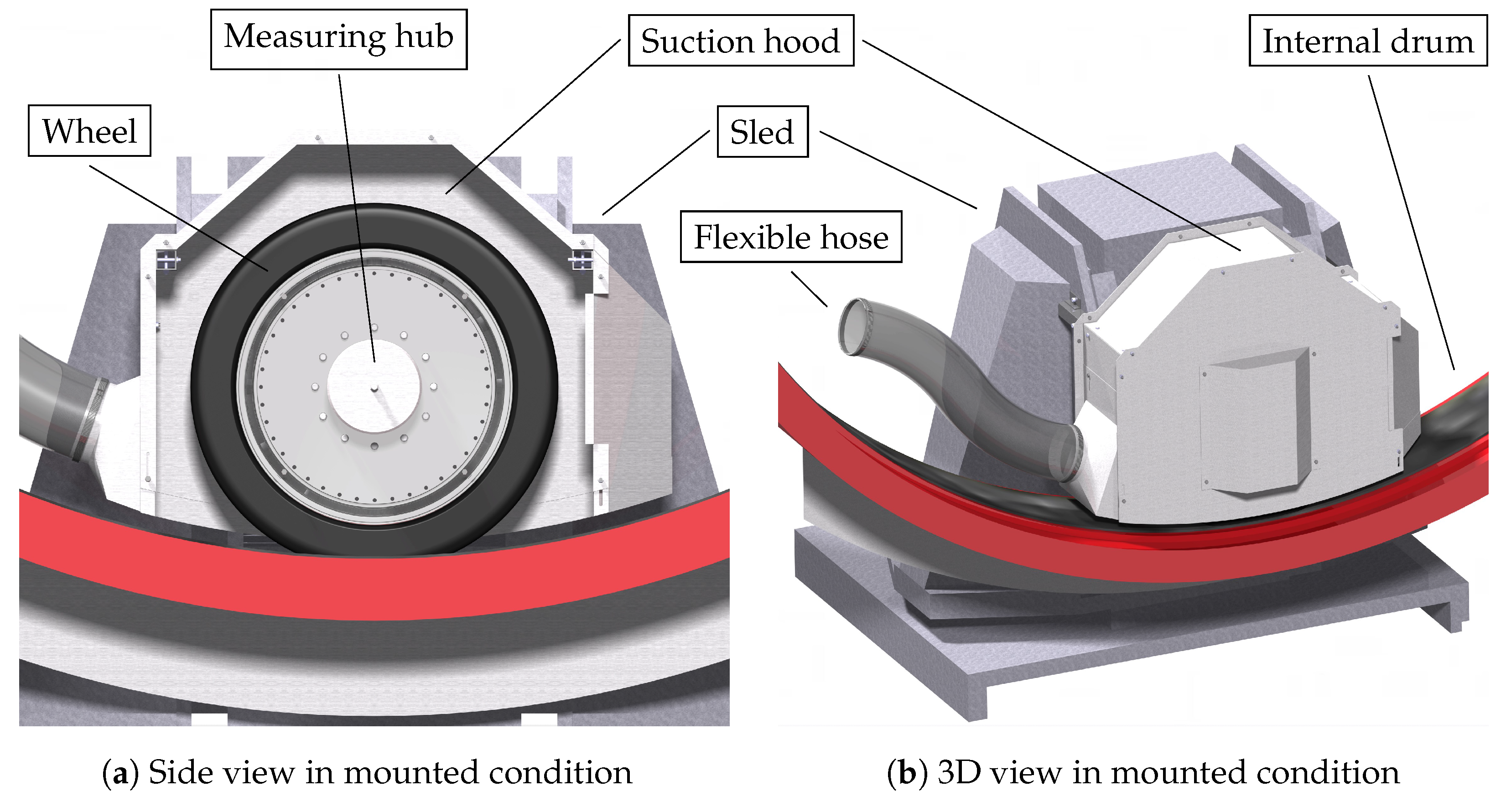
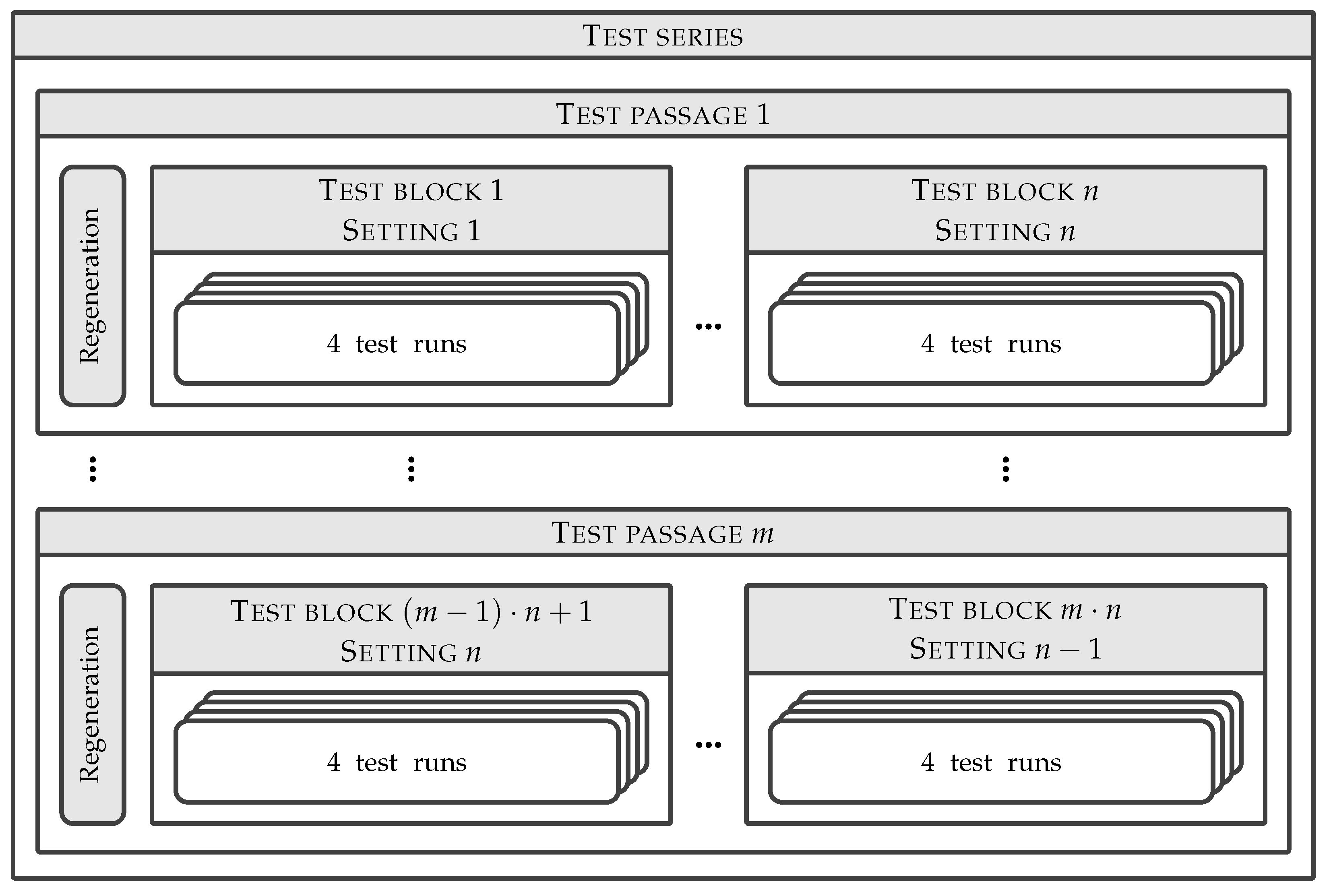

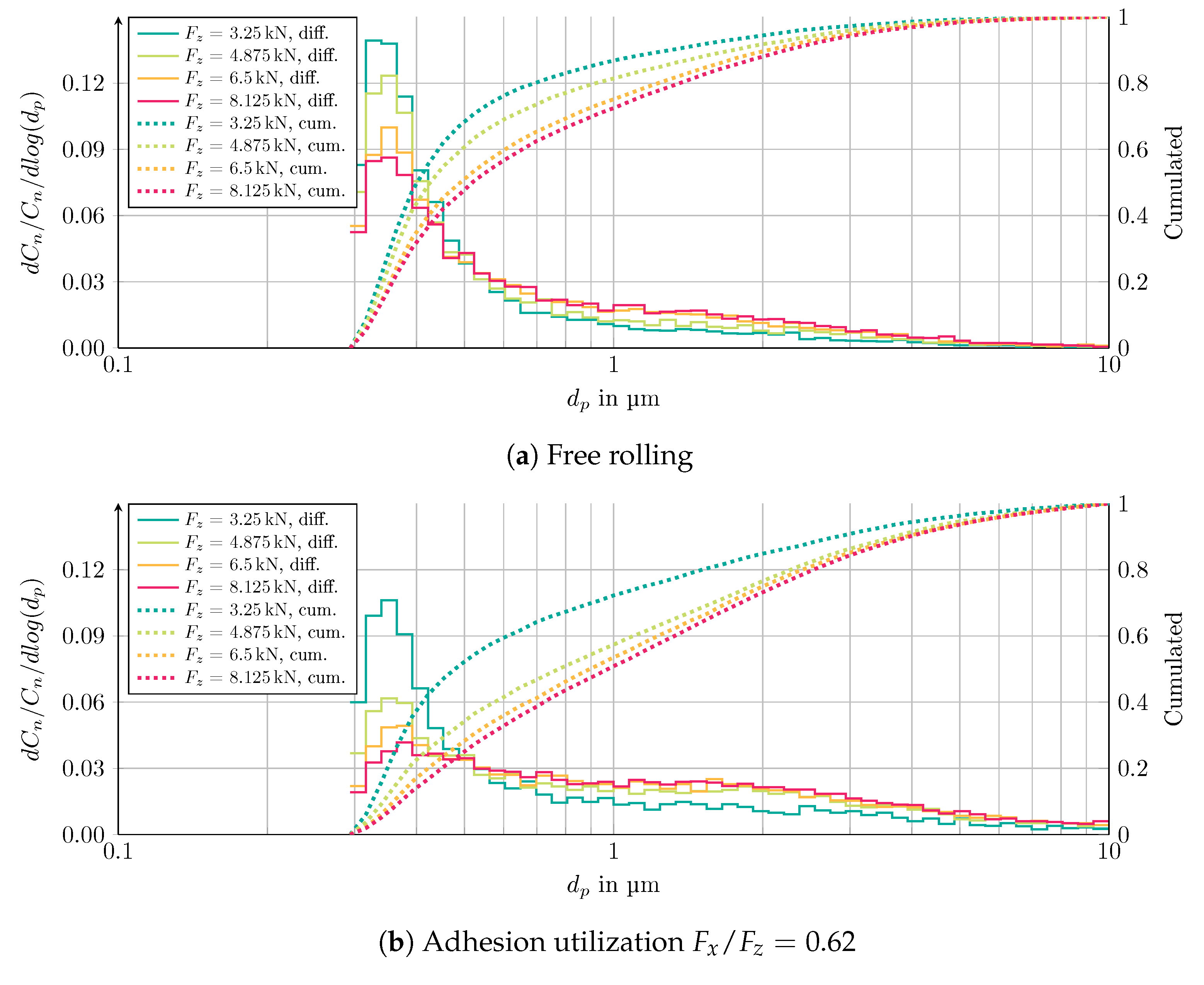
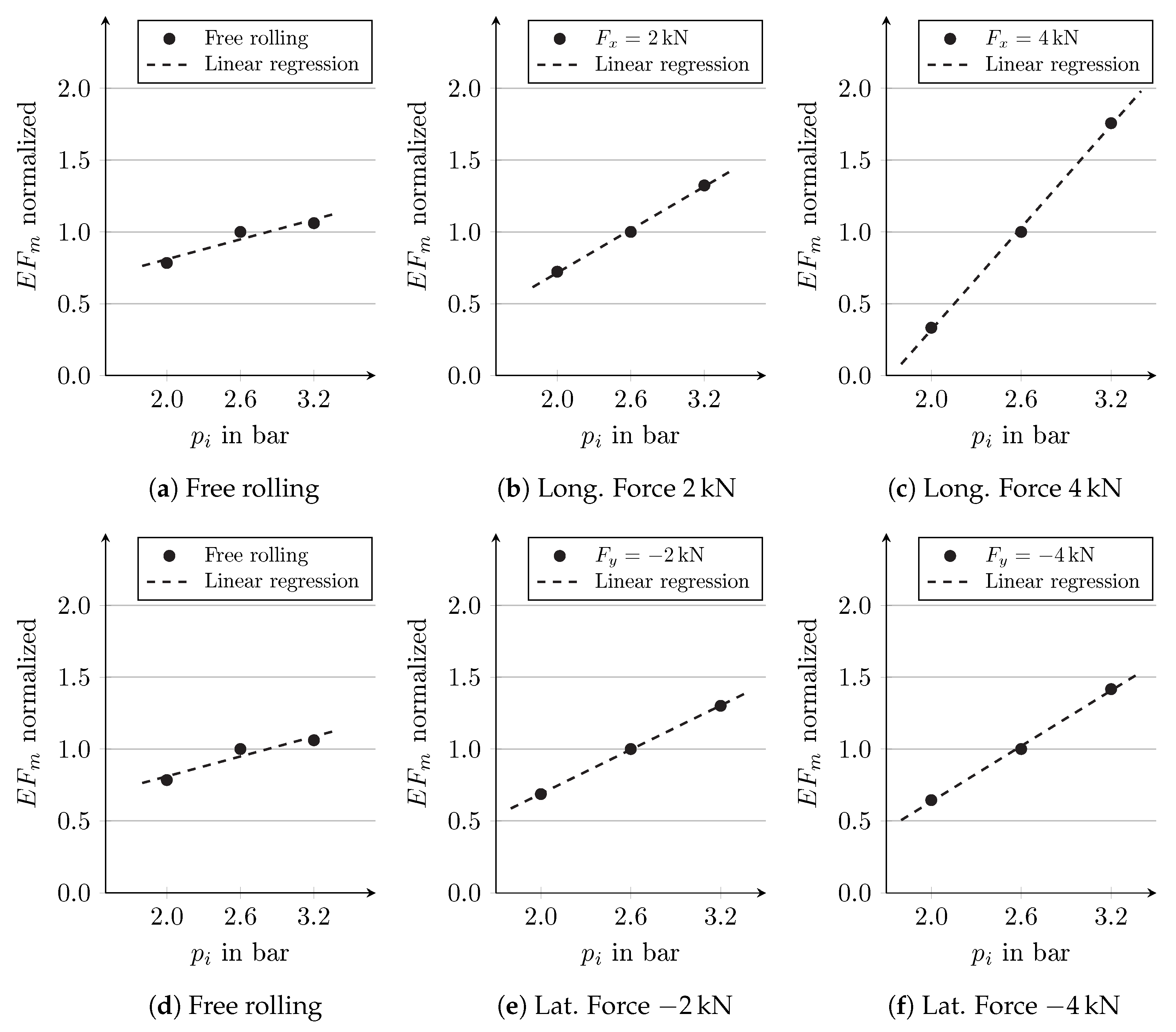
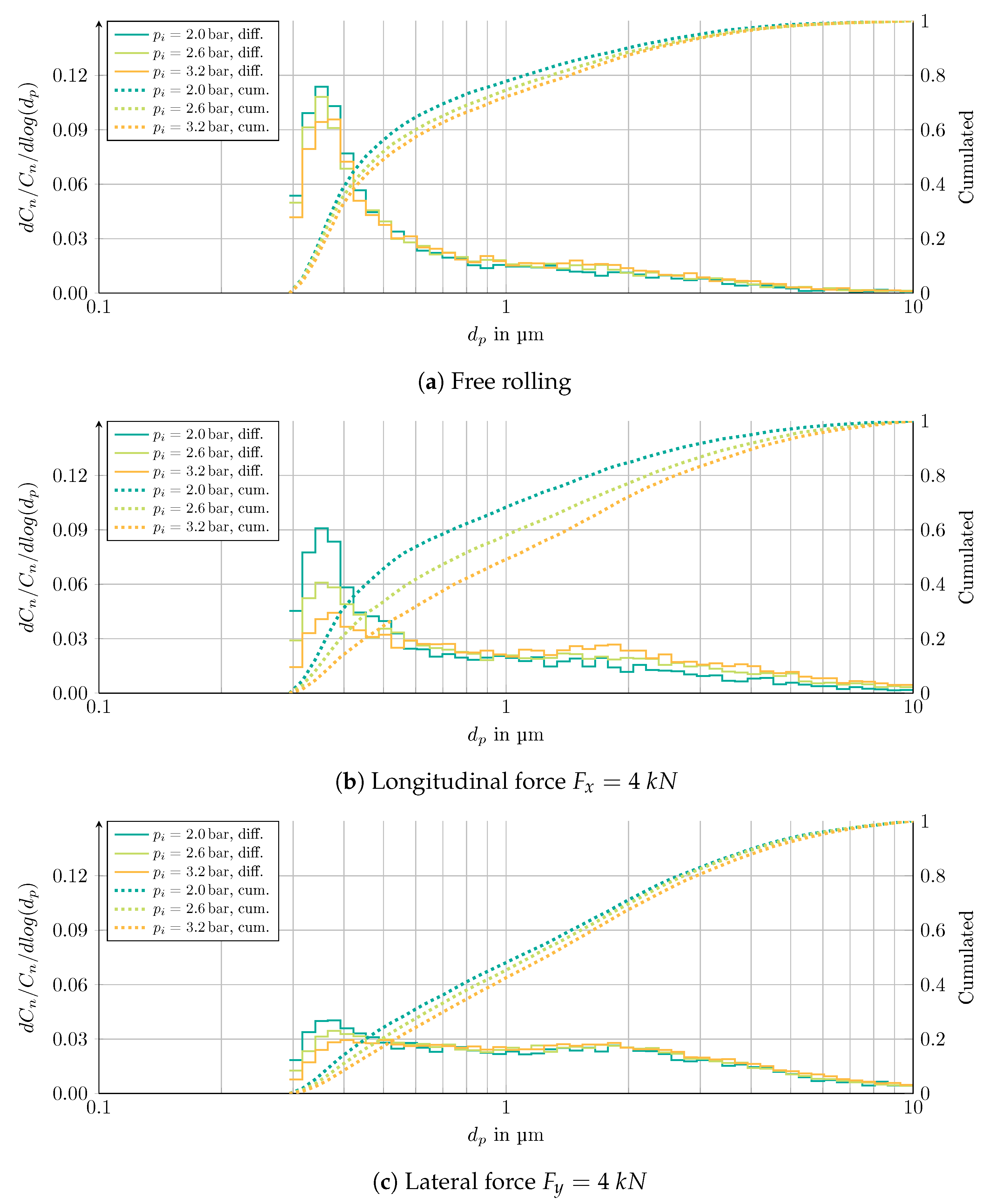
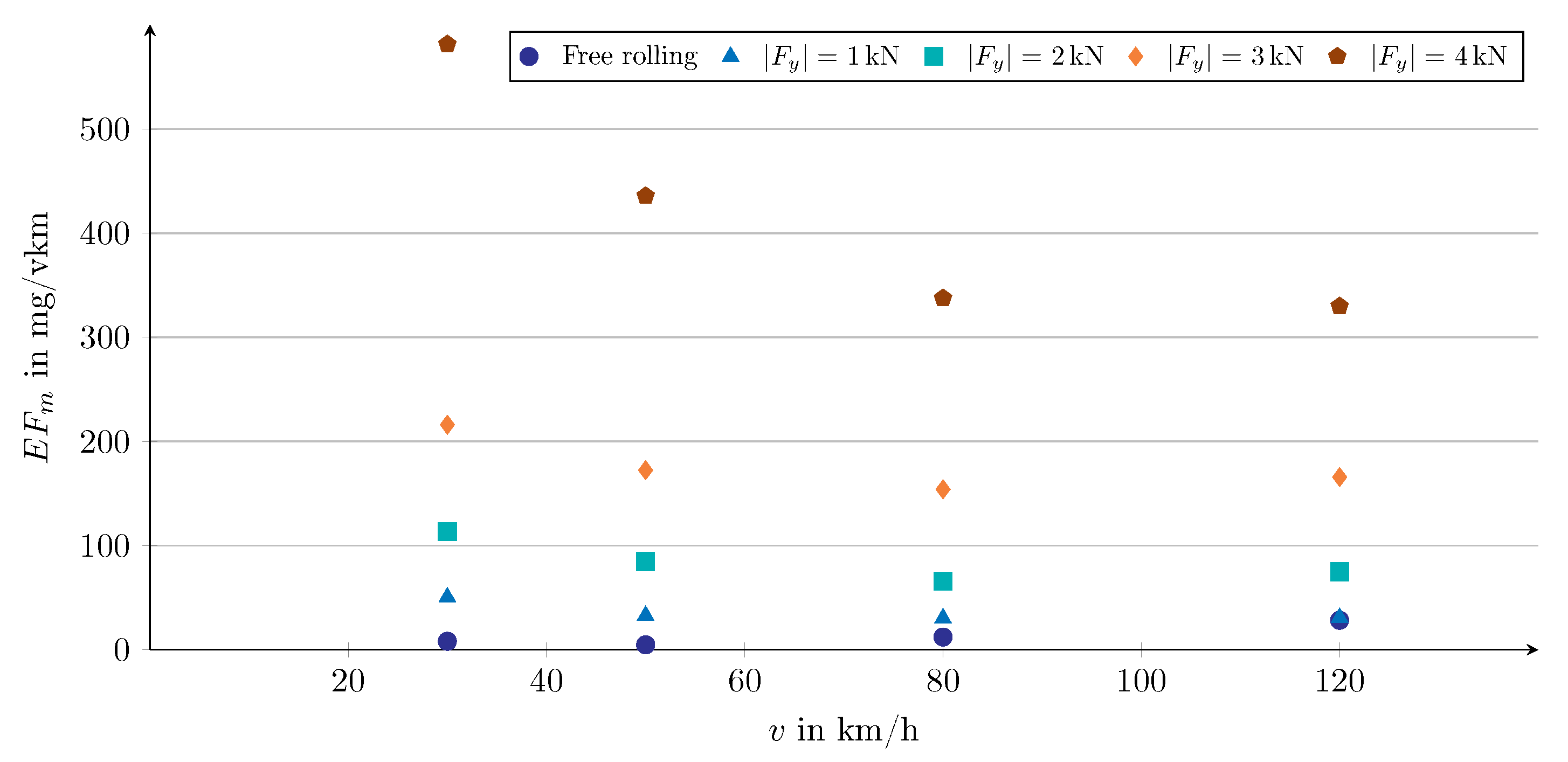

| Test Series Vertical Load | Test Series Infl. Pressure | Test Series Driving Speed | |
|---|---|---|---|
| Section | Section 3.1 | Section 3.2 | Section 3.3 |
| Vertical load in | 3.25 (I), 4.875 (II), 6.5 (III), 8.125 (IV) | 6.5 | 6.5 |
| Infl. pressure in | 2.6 | 2.0, 2.6, 3.2 | 2.6 |
| Driving speed in | 80 | 80 | 30, 50, 80, 120 |
| Long. force in | (I): 0, ±0.5, ±1, ±1.5, ±2 (II): 0, ±0.75, ±1.5, ±2.25, ±3 (III): 0, ±1, ±2, ±3, ±4 (IV): 0, ±1.25, ±2.5, ±3.75, ±5 | 0, ±2, ±4 | — |
| Lateral force in | — | 0, ±2, ±4 | 0, ±1, ±2, ±3, ±4 |
| Adh. utilization or | 0, ±0.155, ±0.31, ±0.465, ±0.62 | 0, ±0.31, ±0.62 | 0, ±0.155, ±0.31, ±0.465, ±0.62 |
| Camber angle in ° | 0 | ||
| Ambient temp. in °C | 25 | ||
Disclaimer/Publisher’s Note: The statements, opinions and data contained in all publications are solely those of the individual author(s) and contributor(s) and not of MDPI and/or the editor(s). MDPI and/or the editor(s) disclaim responsibility for any injury to people or property resulting from any ideas, methods, instructions or products referred to in the content. |
© 2024 by the authors. Licensee MDPI, Basel, Switzerland. This article is an open access article distributed under the terms and conditions of the Creative Commons Attribution (CC BY) license (https://creativecommons.org/licenses/by/4.0/).
Share and Cite
Schläfle, S.; Zhang, M.; Unrau, H.-J.; Gauterin, F. Influence of Vertical Load, Inflation Pressure, and Driving Speed on the Emission of Tire–Road Particulate Matter and Its Size Distribution. Atmosphere 2024, 15, 502. https://doi.org/10.3390/atmos15040502
Schläfle S, Zhang M, Unrau H-J, Gauterin F. Influence of Vertical Load, Inflation Pressure, and Driving Speed on the Emission of Tire–Road Particulate Matter and Its Size Distribution. Atmosphere. 2024; 15(4):502. https://doi.org/10.3390/atmos15040502
Chicago/Turabian StyleSchläfle, Stefan, Meng Zhang, Hans-Joachim Unrau, and Frank Gauterin. 2024. "Influence of Vertical Load, Inflation Pressure, and Driving Speed on the Emission of Tire–Road Particulate Matter and Its Size Distribution" Atmosphere 15, no. 4: 502. https://doi.org/10.3390/atmos15040502
APA StyleSchläfle, S., Zhang, M., Unrau, H.-J., & Gauterin, F. (2024). Influence of Vertical Load, Inflation Pressure, and Driving Speed on the Emission of Tire–Road Particulate Matter and Its Size Distribution. Atmosphere, 15(4), 502. https://doi.org/10.3390/atmos15040502







